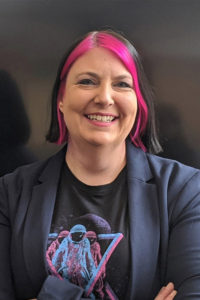
For most people, the word ‘cyborg’ is the promise of future technological advancement—the revolutionary fusion of human and machine, an idea that runs rampant in science fiction novels.
For some, however, cyborgs are no longer fictitious ideas from the future.
Tamara Banbury, a Carleton University PhD candidate in communications and media studies, is a self-proclaimed voluntary cyborg. She has one microchip embedded in each of her hands.

Banbury said “Never Gonna Give You Up” is one of her favourite music videos.
Banbury said she coined the term “voluntary cyborg” to describe “people who are voluntarily embedding technology into their bodies.”
Voluntary cyborgs can use their chips to unlock car, home and office doors, store personal data, and share data with smartphones, according to VivoKey, a chip producer that promises to revolutionize the way their customers live through “just a wave of their hand.”
Banbury said her fascination with cyborgs began when she was volunteering as an undergraduate student at the Military Museum in Calgary. There, she interacted with numerous veterans, many of whom wore prosthetic legs due to injuries in the field.
Banbury, who describes herself as a naturally curious person, started asking questions and eventually combined her interest in technology with human curiosity. The fusion of human and machine fascinated Banbury enough to attend BDYHAX, a conference in Austin, Texas.
According to its website, BDYHAX is a conference for “body hackers” to learn about “human augmentation, transhumanism, and biohacking.” Attendees can have microchips implanted into their body on the conference floor, becoming “voluntary cyborgs” in seconds.
At the conference, Banbury purchased a pre-loaded needle injector with a microchip inside. The injection process, she said, was relatively painless.
A local Ottawa body piercer did the job in seconds: pinching the skin on the back of the hand, the body piercer inserted the needle into the pinched skin and injected it into her hand. There were no stitches, no scars and no way for the naked eye to tell a chip had been implanted.
Banbury programmed the chip herself and can rewrite the data with an app on her phone.
The intersection of human and machine is complicated by the data stored and produced inside the body, and the question of who owns it, Banbury said.
“The law becomes a confused gray area when you start putting objects inside physical bodies,” Banbury said. “Nobody knows who owns the object when it’s inside a body.”
These issues of privacy rights, data collection and ownership could become dominating issues if cyborg subculture becomes more mainstream, Banbury said.
She said that despite the legal complications, she believes it is likely voluntary cyborgs will become the norm.
“I think cyborgs will become more popularized in the future,” Banbury said.





